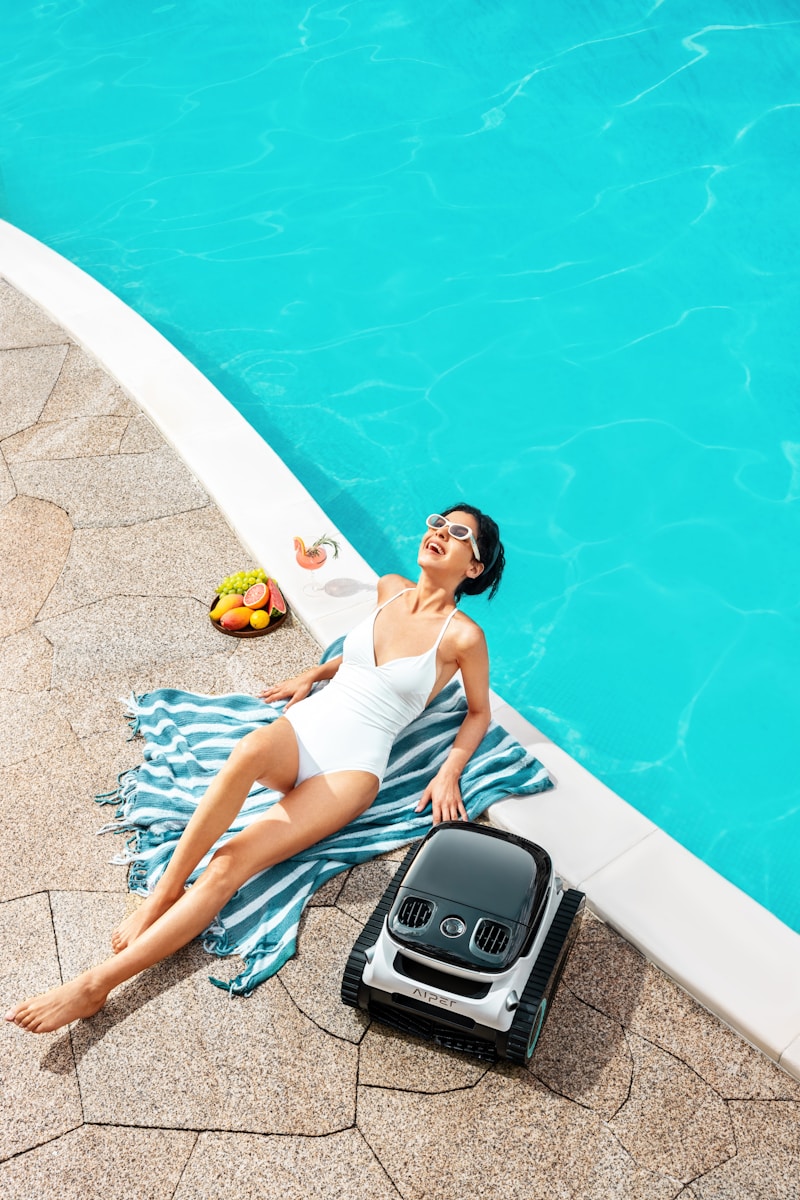
The summer afternoons spent poolside do not need to turn into the same old monotonous routine day after day. If your aim is to add some thrill and liveliness to your mini paradise of a backyard, then the blue and yellow log roller in the pool is just what your dreams are made of. The bold and colorful inflatable toy has become the most sought-after option by families who want the trifecta of fitness, fun, and friendly rivalry all rolled into one easy-to-manage solution.
Why the Blue and Yellow Log Roller is Taking Over Pools
Pool log rollers have become very popular lately and there are some good reasons behind it. These log-shaped inflatables will stretch your balance and at the same time, you will get a complete workout which will be so much fun that you won’t even realize you are exercising. Just like the floating pool toys that lure you into the sunbathing mode, a log roller, on the contrary, will keep you busy and will require your full engagement, focus, and even your acceptance of being splashed.
One thing that makes the log roller of blue and yellow so special is the fact that it attracts people of all ages. The color combination is not only for good looks, but it also has a functional side. The bright colors help the roller to be easily seen in the water which is very important from the safety point of view. It will be very easy for the lifeguards and adults supervising the children to know where the movement is and that will consequently lower the risk of accidents.
What Makes This Color Combination Special
The blue and yellow design has turned out to be an industry standard for numerous reasons. Pool water is blue, and yellow is the color that contrasts the most with it, hence yellow is easily noticed. This combo has been adopted because of its ability to minimize eye strain during long playing periods and, at the same time, it is good for the camera allowing for those Instagram-worthy summer moments. In addition, these colors are neutral and therefore they attract everyone regardless of the gender or age, which makes them perfect for family entertainment with kids and grandparents.
Choosing the Right Blue and Yellow Log Roller for Your Pool
Log rollers differ from one another in quality. Depending on your budget, you will meet a variety of log rollers in the pool that all boast features—some may even be quite extravagant. The typical size for home pools is about 60 inches long, which allows enough surface area for stability but still can be easily put away for storage.
Size and Weight Capacity Considerations
Prior to making the purchase, you should first measure the size of your pool. For safe rolling, a minimum of 8 feet space free of any obstacles will be required. Most of the blue and yellow log rollers which are of standard type support the weight up to 200 lbs of the user but some commercial ones can support the heavier weight. In case of purchasing for teenagers or adults, it is advisable to check the weight limit and make sure it is safe for use.
The depth of the pool is also a factor to be considered. It is not necessary to have a pool of Olympic size, but still, the water depth should be at least 4 feet to be able to carry falls without harm. Pools that are not very deep are good for the youngest kids, but adults need deeper water to reducetheir risk of injury due to falling over during play.
Material Quality: PVC vs. Vinyl
The highest quality log rollers are made of thick PVC with stitching that has been reinforced. These models are more resistant to puncturing and will keep their shape all through the season. The low-cost vinyl alternatives may be less expensive initially, but they will be easily subjected to air leaks and faster deterioration from being in contact with chemicals used for pool maintenance. It is advisable to buy products that have several air chambers—when one part gets deflated, the roller still works at least partly instead of being totally incapacitated.
Getting Started: Your First Time on a Log Roller
Your initial try at controlling the blue and yellow log roller in the pool will probably result in a splash, which is very much the case in such a situation. The trick is to take it with the right mindset and technique.
Beginner Techniques That Actually Work
Begin with the log as a seat instead of a standing position. For the sake of safety, the roller should be placed against the wall of the pool, then one should mount it slowly and cautiously. Keep the gravity center low and the core tight. Make small, precise movements instead of making big weight shifts. It’s just like riding a bike—the tiny corrections are better than the big ones.
At the time, when you feel perfectly safe ‘ sitting down, move to ‘kneeling position. This mid-way position is going to help you build a strong core which is a requirement for a standing position. Set a goal of holding the balance for 10-15 seconds before making the move to standing. Once you are standing, keep your knees a bit bent and your arms out for balance. Concentrate on a fixed spot that is beyond the pool instead of looking down at the log.
Common Mistakes to Avoid
neophytes usually commit the same mistakes. Do not clutch the log with your feet; it will cause tension and lead to losing balance. Do not gaze at the water as this will disturb your balance. Do not resist the turn; rather, go along with the log’s natural rotation. Plus, perhaps most importantly, do not lose hope. Even the skilled ones often fall off—it is a source of fun.
Maximizing Fun: Creative Games and Challenges
Rolling the log or the inner tube in the pool is much more fun when there is given a competitive and imaginative twist.
Competition Ideas for Pool Parties
Organize log roller tournaments where the participants will compete among themselves to remain balanced for the longest period. Develop knockout rounds and make the challenges more difficult by introducing waves or asking for certain poses. Give “log jousting” a go, where two individuals on separate rollers try to push each other off with pool noodles (of course, safely!). Time trials are also great, just see who can roll from one end of the pool to the other the quickest.
At children’s birthday parties, use the log roller for children’s obstacle courses. Partner it up with diving for rings, swimming through hoops, and other pool toys for a complete water challenge course.
Fitness Routines on Your Log Roller
The workout capabilities are acknowledged by fitness lovers. To make your leg workout tougher, try squatting on the log. Do yoga poses for a professional level of balancing challenge. Do crunches while sitting to work on your abdominal muscles. Just long-lasting unbalancing is producing a lot of underpinning of the body muscles and losing calories.
Maintenance and Storage Tips
The proper maintenance and taking care of your log roller can very much prolong its life expectancy. After every single use, just rinse it off with clean water in order to take off any chlorine residue. Make sure it is totally dried out before you put it away, as this will stop mildew from growing. Keep it in a cool place that is shaded and not exposed to direct sunlight, as the sun’s rays can over time harm the material of your log roller.
Extending Your Log Roller’s Lifespan
It is important to routinely inspect the equipment for any damages, particularly at the seams and valve areas. Very small rips can be repaired by using vinyl repair kits that are usually meant for pool toys. Also, do not over-inflate it because this will put unnecessary stress on the seams. During the inflation process, the roller should be filled to around 80-90% of its total capacity—it should feel firm but not rock-hard.
If you do not plan to use the roller for a long time, it is better to deflate it partially rather than completely. This will avoid the formation of permanent creases. Apply the UV protectant spray specifically made for inflatables at the beginning of each season as a preventive measure against the sun’s harmful effects.
Taking Action: Making the Most of Your Purchase
Are you ready to get your blue and yellow log roller and take it home? First, it is necessary to make clear safety rules for all users. Always have a “spotter” when using the log roller, especially for children. If you are serious about teaching yourself the skill, create a practice schedule—consistency is better than occasional marathon sessions.
Think about buying extra equipment such as a pool ladder with handrails for easier mounting or extra rollers for multiple users at the same time. Capture your progress with videos—self-watching can help improve technique faster than you expect.
However, the most important point of all is to go through the learning curve. The blue-and-yellow log roller in the pool is not about being perfect but about having fun, making memories, and keeping fit. Every fall is a tale to tell, and every successful ride is a victory worth cheering.
Frequently Asked Questions
What age is appropriate for a blue and yellow log roller?
The majority of producers suggest an age limit of 13 and over for full-sized rollers because of the needed balance and strength. Little ones may play on them with adult supervision very close and in shallow water, yet they should commence sitting rather than standing.
How long does it take to inflate a pool log roller?
Most of the blue and yellow log rollers can be inflated within 3-5 minutes when using an electric pump. The duration for manual pumping varies between 10-15 minutes depending on one’s physical condition. Boston valves help to speed up the process and also ensure that no air escapes during inflation.
Can I use a log roller in saltwater pools?
Indeed, but make sure to wash it very well after every use. In comparison to chlorinated water, saltwater is more corrosive and if it is not cleaned it will ruin the materials more quickly. It is recommended to apply UV protectant more often when using saltwater.
How do I repair a puncture in my log roller?
The use of a vinyl repair kit that is generally found in pool supply stores is recommended. First, clean and dry the area completely, then apply the adhesive patch, and wait 24 hours for it to be cured before inflating again. When it comes to seam tears, it is better to think about getting a professional repair or replacement.
Is it normal to fall off constantly as a beginner?
Absolutely! Sporty people also find it hard in the beginning because log rolling works stabilizer muscles that we hardly use in other exercises. After 3-4 practice sessions, a great improvement can be seen. Falling down is part of learning and it is fun as well.
Can adults use the same log roller as kids?
In case the roller supports the respective weight recommendations, the answer is yes. But, grownups might consider the usual 60-inch versions a bit cramped. In that case, opt for professional-quality or longer ones (72+ inches) if you want adult performance that is more comfortable.
How much pool space do I need for safe log rolling?
It is crucial to establish a buffer zone of at least 8-10 feet all around. You must have sufficient area to drop safely without making contact with the pool’s barriers, ladders, or other objects. For adolescents and grown-ups, the minimum water depth should be 4 feet; for unsupervised kids, it should be 3 feet.





